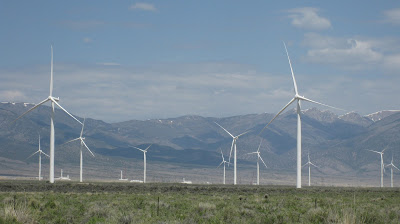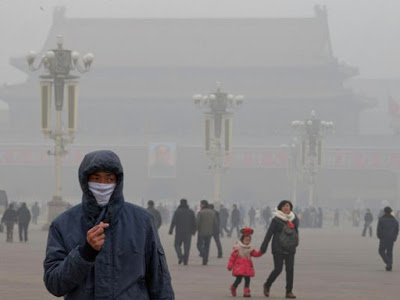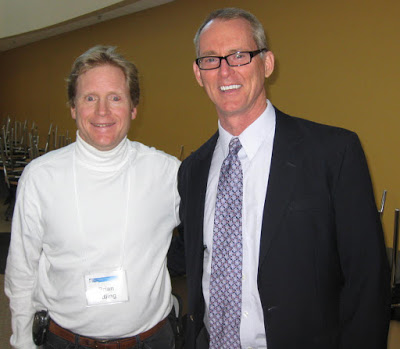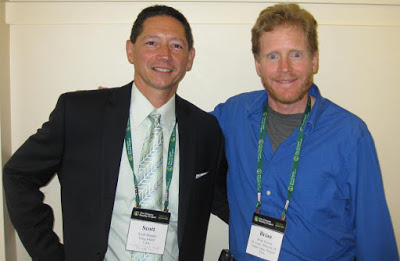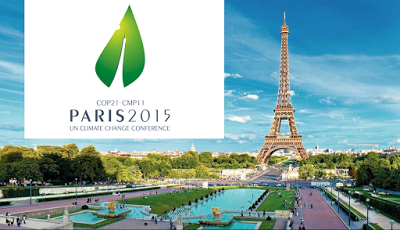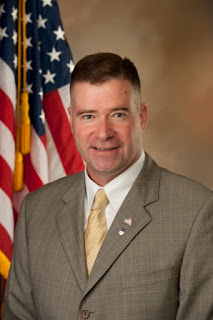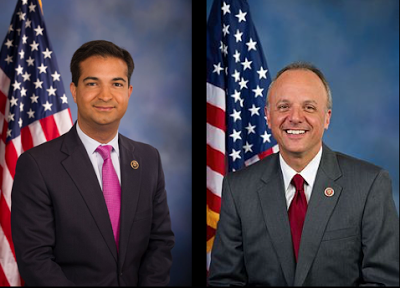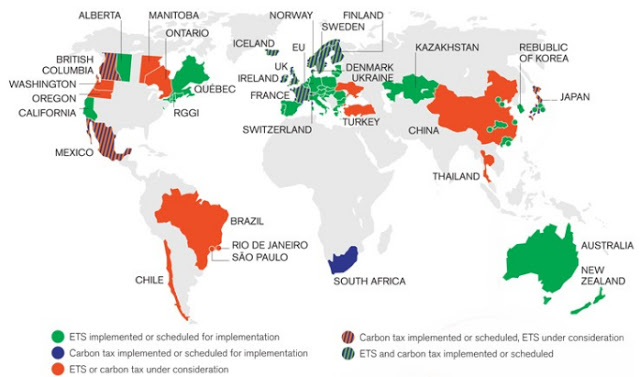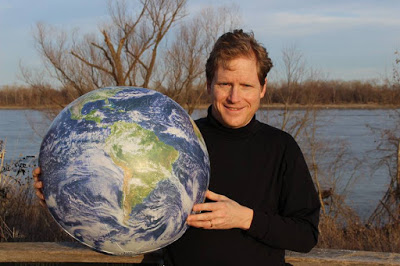 |
Brian Ettling in front of the U.S. Capitol getting ready to lobby
Congressional Offices on November 17, 2015. |
Below is my speech text that I gave at St. Louis South County Toastmasters on March 30, 2016. My speech text is a short summary of the February 16, 2016 Citizens’ Climate Lobby media packet: Supreme Court stay on the Clean Power Plan.
This speech had a total time limit of 11 minutes. I had a 6 minute prepared speech, which is the first half of this blog. I then had a 5 minute question and answer period. I will then cover the questions and how I answered in the second part of the blog.
Part I
The title: Our plan for a healthy planet IS gaining traction with Congress
Good evening, volunteers of Citizens’ Climate Lobby and all of you here.
Today, I want to report on 3 things:
The recent bad news, our next step forward, and then good news.
First, Let me share the background information:
December 2015 in Paris, 195 nations agreed to limit global warming to 3.6 degrees Fahrenheit above pre-industrial levels. This goal was based on the broad understanding that exceeding 3.6 F would result in nasty consequences such as sea level rise, food shortages, worsening storms, and extreme heat waves likely to outpace our civilization’s ability to adapt.
President Obama went to Paris promising that the United States would reduce carbon emissions up to 28 percent by the year 2025. He confidently made that pledge because of a new Environmental Protection Agency regulation, known as the Clean Power Plan. It aims to reduce carbon dioxide emissions at new and existing electric power plants. A strong commitment from the U.S. was essential to getting other nations to make pledges of their own.
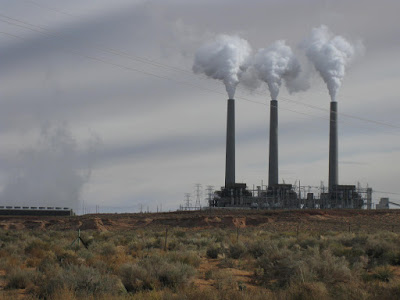 |
Image from Brian Ettling from November 2010. Navajo Generating Station, coal electric plant.
located near Page, Arizona. It’s considered to be the 3rd largest emitter of CO2 in the U.S.. |
Now, the Bad News.
February 9, 2016, U.S. Supreme Court voted, in a 5 to 4 ruling, to delay the implementation of President Obama’s Clean Power Plan until legal challenges are resolved.
Just how disastrous is the Supreme Court’s recent ruling?
Worse than you realize.
Court decision raises uncertainty
The U.S. Paris climate commitment was based on President Obama’s executive action. Unfortunately, it is now facing aggressive challenges in U.S. courts. This Supreme Court stay raises international doubts if the U.S. can now meet its obligations. People worldwide may worry if this regulation will eventually be upheld.
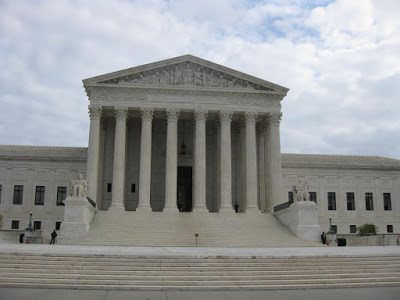 |
| Image from Brian Ettling of the U.S. Supreme Court Building. November 2015. |
With this disappointing Supreme Court action, this leads to my second point…
2. Our legislative solution is the best step forward.
What is the meaning of that ruling for us today?
• The court “stayed,” did not overrule, the Clean Power Plan.
• It is a temporary stay or hold.
• It highlights the weakness of addressing climate change through executive action.
• The Supreme Court could knock this executive action down.
• Even if the Court upholds the plan, a future U.S. President could cancel it.
• The best and most permanent solution is Congressional action, which will last across presidencies.
• This underscores the importance of our work for Congress to pass our proposal. It is market-based approach favored by economists on both the left and the right.
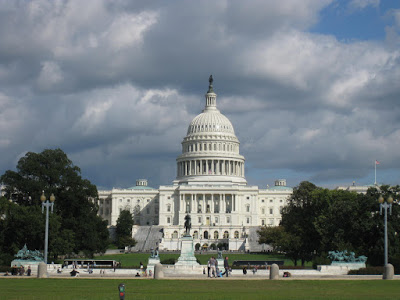 |
| Image from Brian Ettling of U.S. Capitol Building, October 2010. |
Citizens’ Climate Lobby recommends a policy known as Carbon Fee and Dividend,
– This fee starts at $15 per ton of fossil CO2 emitted.
– It is placed at the source, coal mines ,oil wells, and U.S. border.
– It increases each year by $10.
– Clean energy is cheaper than fossil fuels within a decade.
– All of the money collected is returned to equally American households on an equal basis.
– Under this plan, 66 percent of all households would break even or receive more in their dividend check than they would pay for the increased cost of energy. This protects the poor and middle class.
– A predictably increasing carbon price will send a clear market signal, for entrepreneurs and investors to fully invest in the new clean-energy economy.
This is a market-based solution.
 |
Image from Brian Ettling of solar panels behind the Cold Strings Station Motel,
RV Park and General Store, Cold Springs, Nevada. May 2012 |
A 2014 study from Regional Economic Models, Inc., (REMI) found our policy would achieve within 20 years a 52 percent reduction in CO2 emissions and add 2.8 million jobs. In 20 years, the dividend checks would also increase household incomes for a family of four up to close to $400 a month or $4800 a year, which would more than cover the increasing fuel costs.
Sounds great, you may be thinking, but what are the chances that this dysfunctional and partisan Congress will take bipartisan action to address climate change?
Actually, there is more hope than you might think.
3. The Good News: the progress happening with Congress
1. In September 2015, GOP Rep. Chris Gibson from New York introduced House Resolution 424. This resolution states that climate change could have a negative impact on our nation and that Congress should start working on solutions.
It is now cosponsored by 12 other Republicans.
2. A second breakthrough happened last month: the formation of the bipartisan House Climate Solutions Caucus, co-chaired by Florida GOP Rep. Carlos Curbelo and Democrat Rep. Ted Deutch from Florida.
With this bad news and good news, here is our take home message for you today:
The Supreme Court’s decision to delay the Clean Power Plan exposes the folly of relying solely on executive action to solve the most critical problem facing our civilization. As more Republicans express a willingness to come to the table, Congress must pass our Carbon Fee & Dividend proposal.
Our solution can bridge the huge partisan divide.
At this point, I will take questions from the audience for the next 5 minutes.
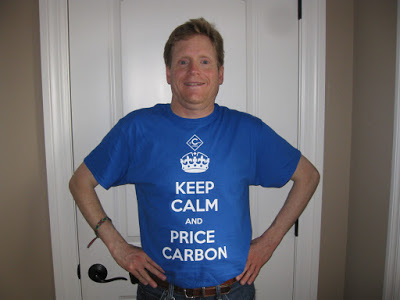 |
| Image of Brian Ettling with his t-shirt promoting Citizens’ Climate Lobby, May 2015. |
(As soon as I can upload the images from my speech into the video, I will then post my video on YouTube with a link here)
Part II
I will share below the questions I received from the audience and my attempts to answer the questions.
1. How do I forsee the dividend program continuing when the projection is that fossil fuel usage will decrease? As a result one could see that there would be less money to return to households and eventually it would not be able to sustain the increased costs of fuels.
The was a question asked by my fellow Toastmaster, Erin. While I did spend hours trying to anticipate questions that would be asked of me, I will now admit that I was stumped by this question.
Here is how I tried to answer the question on the spot:
“According to the 2014 REMI study, the dividend keeps going up.”
Since I was stumped, I tried to ask Erin if she meant if the costs of fossil fuels would be higher than the dividend at the end of 20 years.
Erin responded, “If our goal is to move away from fossil fuels and as we use less and less fossil fuels, there would be less money for the dividend.”
Still uncertain how to answer, I gave this reply:
“That is a great question. My understanding from the REMI report is showing is that the revenue for the dividend would keep increasing. As the costs of fossil fuels would keep increasing, it would more than cover the costs. I can always get back to you on that.”
Erin still wanted to press me on the point that we would be using less and less fossil fuels. I responded ‘That is the goal to keep using less and less fossil fuels and emitting less and less carbon dioxide. At that point we will have won and the economy will have switched over to nearly 100% clean energy.’ I then reiterated my point that the dividend would more than cover the costs and I promised to get back to her on that.
Erin still wanted to keep pressing me on this. She was still convinced that the increased carbon taxes and the diminishing use of fossil fuels would cause the dividend checks to get smaller. Therefore, it would not cover the increasing costs.
I tried to respond by saying that “We would be using less and less fossil fuels and it would be covered under the fee, if that makes sense.”
Erin then argued that ‘The fee will eventually go away because we will no longer be able to pay out the dividend.’
I then tried to explain that ‘by that time we will have switched to the clean energy economy and we will no longer have to pay out the dividend.’
Fellow Toastmaster Adam then jumped into the conversation saying, ‘By then, the dividend will be diminished and there will not be enough money to cover the fee.’
At that point, a guest visiting the club then spoke out to defend the carbon fee and dividend. It was hard for me to hear his opinion because he turned his back to me to address Erin and Adam.
To regain control of the question and answer period, I then pivoted to the next Toastmaster who had a question for me.
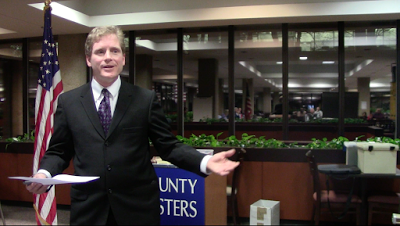 |
| Image of Brian Ettling during his March 30, 2016 Toastmasters Speech |
The response I would like to have given:
This was an excellent question from Erin. Since I am not an economist and I do not run economic models for a living, I felt out of my league trying to answer that question. Thus, I did e-mail Scott Nystrom, Senior Economic Associate at REMI, who was the lead author of the study, for a response. If I do not hear back from Scott, I will make sure to ask staff with Citizens’ Climate Lobby more familiar with the details of the 2014 REMI study how they would have responded.
Since I have been a member of South County Toastmasters for the past five years, I have become friends with Erin and Adam. I even invited Erin and Adam to my wedding last November. Adam and I have very different on politics and climate change. I look at the world through a very strong progressive view with a strong acceptance of climate change. Adam considers himself to be a strong libertarian and he is very doubtful of human caused climate change. We have struck up a friendship through Toastmasters. I have even sought out Adam’s advice for my climate change speeches to be able to better reach his segment of my audience. Adam and Erin are dating. In conversations with Erin, she seems to agree with many of his world views. Thus, I was fully expecting to get skeptical questions from Adam and Erin.
In the past, I have met with Adam to practice my climate change speeches and draw out his questions so I would be better prepared. I debated to do this for this speech. Professional speakers do know how to better control a question and answer session where anything can happen. Some use techniques of having friends in the audience ask a question that they will know in advance how to answer. I did not want to do that trick for this Toastmasters speech because I did want to be able to fully think on my feet. I have given around 100 climate change talks over the past five years. I fielded lots of questions from the audience during these talks. Sometimes I felt I succeeded with my answers with the audience. Other times, I failed because I did not know enough information or my response ended up triggering a contentious argument with the audience member.
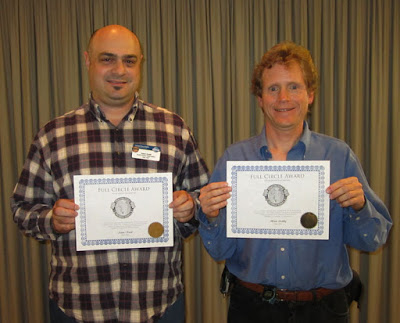 |
| Adam Kutell and Brian Ettling receiving a reward from Toastmasters, May 2012. |
Adam or Erin and I are probably never going to agree on climate change, the policy solutions and other political issues. However, they are still friends and want me to succeed as a Toastmaster and a public speaker. Thus, I wish could have answered Erin’s question more like this:
“Erin, that is an excellent question. Believe it or not, in my previous years of talking about climate change, Citizens’ Climate Lobby and the the REMI Report, nobody has asked me that question before today. I spent many hours trying to prepare for this question and answer period. However, you asked me one question where I will admit my knowledge is limited.
Here is my quick response to attempt to answer your question: My understanding from the REMI report is showing is that the revenue for the dividend would keep increasing over 20 years. As the costs of fossil fuels would keep increasing, it would more than cover the costs.
However, I don’t have any details beyond that so I will do more homework and get back to you. I am fully confident that economists involved with this study are aware of your concern and I have no doubt they have already addressed it.
When Citizens’ Climate Lobby (CCL) commissioned REMI to do this study, CCL deliberately sought out REMI because they ‘are committed to quality data free of ideological taint that you might get from some think tanks.’ REMI is truly nonpartisan advising organizations from the the American Gas Association (AGA) and the Nuclear Energy Institute (NEI) to the National Education Association (NEA) and the International Brotherhood of Teamsters. They have a stellar reputation in Washington D.C. and nationally for providing impartial and totally independent economic analysis.
CCL did not attempt to influence the outcome of the report in any way. Their first priority is a livable world, and we can’t get there without an honest and clear-eyed view of the facts.
Having said that, I can still understand how you are skeptical. I would just ask that you let me dig deeper. Let me see if I can contact the author of the study, Scott Nystrom, and get back to you.
You may find this ironic or funny. I have heard from friends in Citizens’ Climate Lobby that Scott Nystrom is a staunch libertarian, like Adam. He is not a tree hugger like me. He would probably agree a lot more with you on politics than me. However, his day job and passion is running economic models. That’s it. However, since Scott has a similar perspective on economics and politics as you, I have no doubt he has already thought of your question. Let me get with Scott or others who are more knowledgable about the 2014 REMI study and get back with you.”
2. I understand you clearly said that this is a market driven solution and not government regulations. My interpretation is that it is not market based. It is not the free enterprise. Corporations are not going to freely volunteer do this. It will only happen with major rigid government controls. Can you please explain that?
This second question was from my friend and fellow Toastmaster Jim Bubash. He freely calls himself a “climate denier,” so I was not surprised that he would ask a question that was critical of my speech.
From the readings I did on the Citizens’ Climate Lobby website, I felt much better prepared for Jim’s question and more confident in my answer.
My response: “That is a great question because already ExxonMobil, Walmart, BP, etc. are already doing their own internal carbon tax. They anticipate that we are going to eventually get a carbon tax. Keep in mind that nearly 50% of global emissions of countries worldwide, they are now doing either a carbon tax or cap and trade. So, this is happening more and more on a global scale. More and more business are saying that ‘we should have a carbon tax’ and countries throughout Europe are doing it. China now has seven provinces with cap and trade. This year they are suppose to implement a nationwide (cap and trade) program. There is actually a global movement towards it. There are actually a lot companies saying that we should have a carbon tax.”
Jim was not happy with my answer, so he then reiterated:
“As far as you explained, worldwide and in the United States, wouldn’t this need major government regulations?”
I replied, “It does not (need major government regulations). It is the simplest plan you can come up with. Are you familiar with former Secretary of State George Shultz?”
“Yes,” Jim responded.
I answered, “George Shultz is on is actually in favor of our plan. He is on the Advisory Board for Citizens’ Climate Lobby. He has said (the carbon fee and dividend plan) is the simplest, most transparent, and the easiest to administer because basically you collect the fee at the source, the coal mine, oil mine or the U.S. border and you return that revenue. It is strictly passing through the government. You do not have to increase any regulations with this.
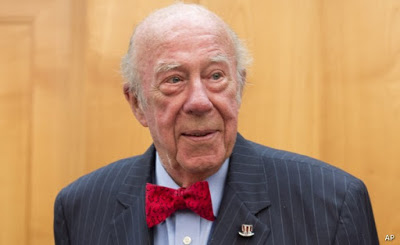 |
| Former Secretary of State George Shultz. Image Source: newsmax.com |
It is a much more efficient plan than President Obama’s Clean Energy Plan. President Obama’s plan only reduces emissions 30% over 20 years, whereas (Citizens’ Climate Lobby’s carbon fee and dividend) reduces carbon emissions over 50% (over 20 years). Thus, it is much more efficient and it uses the market to do that.”
Final Thoughts
For the final minute of my question and answer period, Cathy Bell, a guest who found out about the Toastmasters meeting from an announcement I put on the Climate Reality-St. Louis Meetup.com page, gave this comment to the audience:
“This is not a question but to really address what some people are saying. If you owned a restaurant and you dumped your garbage into the street, you would not be allowed to do that. (Garbage collection) is supposed to be factored into your cost of business that you pay someone to collect your garbage. Yet, we are letting these companies dump what this is, which is garbage, which is going to poison our planet and going to destroy this civilization and the human race. We are letting them dump their garbage into our atmosphere and poison all of us.
They should not be allowed to do that no more than you or I should be allowed to open a restaurant and dump our garbage into the street. As far as the costs going up for households, look at what is happening in California with the costs of solar. The sun is free. The costs of solar is going to come down and it is already coming down. (Unfortunately, the U.S. Government) is subsidizing fossil fuels to the tune of billions of dollars of our tax dollars.”
At this point, my 11 minutes were up, I had to cut off Cathy, end my time, and thank the audience for their time.
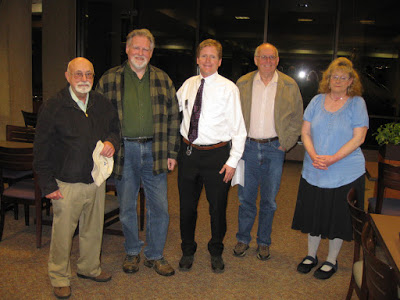 |
Friends who attended my Toastmasters speech from March 30, 2016
From left to right: Ron Trimmer, Don Diekmann, Brian Ettling, Robert Vest, and Cathy Bell. |
In that final minute of my question and answer period, I did think that Cathy did a eloquent job of expressing a key point of climate scientists, economists, and climate activists. We must stop using our air supply as an unregulated and unpriced sewer to dump our carbon emissions. Citizens’ Climate Lobby’s carbon fee and dividend is just a tool to correct a market failure. This market weakness could led to very nasty consequence if we don’t act fast to reduce the threat of climate change.
Just like what I talked about in my speech, Citizens’ Climate Lobby’s carbon fee and dividend is a solution that can help create a more livable and sustainable planet.
Thank you for reading my blog.

